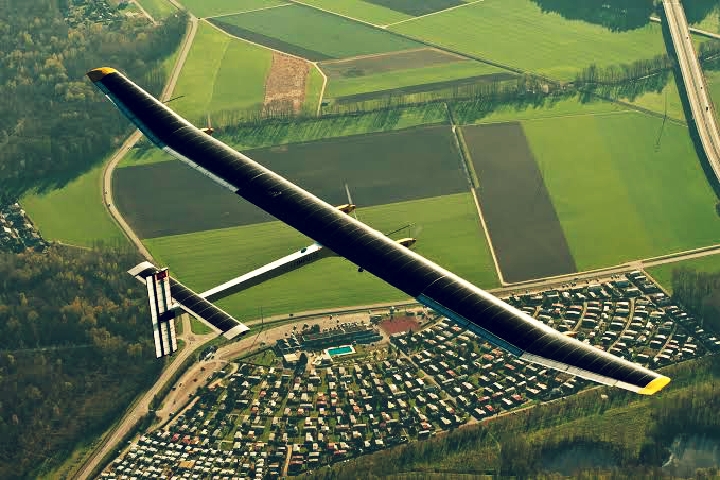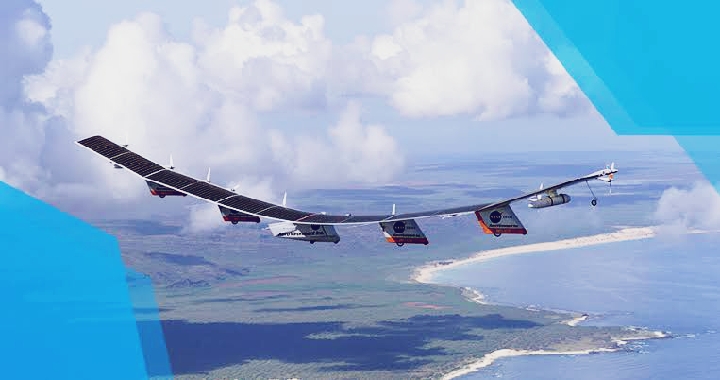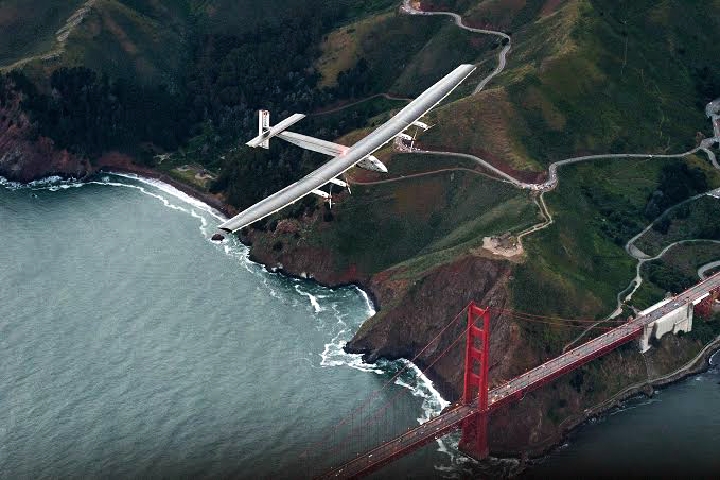Solar Airplanes The coming of sun based planes denotes a critical crossroads throughout the entire existence of flying, mixing development with supportability to rethink the fate of flight.The flying business is under expanding strain to decrease its carbon impression as ecological and environmental change concerns develop. Notwithstanding their high effectiveness, fuel-controlled airplane fundamentally increment ozone depleting substance outflows. Accordingly, sun based planes have arisen as a promising other option, saddling the unlimited force of the sun to accomplish flight.Photovoltaic cells embedded in the wings of solar airplanes turn sunlight into electrical energy. This energy controls the airplane’s electric engines, empowering it to fly without depending on petroleum products. Although solar-powered flight is not exactly novel, recent technological advancements have made it more feasible than ever. Developments in lightweight materials, energy capacity, and sunlight based proficiency have radically worked on the presentation and unwavering quality of these airplanes, making them progressively possible for different applications.The ascent of sun powered planes is something beyond a mechanical accomplishment; it addresses a more extensive shift toward practical flight. These airplanes offer the possibility to lessen the natural effect of air travel, especially for long-span flights where fuel utilization is a basic concern. Besides, sunlight based planes have the extraordinary capacity to fly ceaselessly, possibly for a really long time or even weeks, by putting away overabundance energy during sunshine hours for use around evening time.While still in the trial and formative stages, sunlight based planes are ready to assume a significant part coming soon for flight. Sun oriented controlled flights could fundamentally have an impact on the manner in which we travel because of mechanical headways, giving a cleaner and more reasonable option in contrast to traditional flying. The advancement of this technology is not only a significant advancement for aviation but also a significant advancement toward a more environmentally friendly future.

Solar Airplane Around The World
The idea of a sunlight based plane circumnavigating the globe has developed from an actually thinking about dreaming into a motivating reality, showing the enormous capability of sustainable power in flight. The excursion of sunlight based planes all over the planet is a demonstration of human creativity, determination, and the tenacious quest for manageability. The most famous illustration of this accomplishment is the Sun oriented Drive project, which enamored the world with its pivotal flight. Solar Impulse 2, a plane built by Swiss pioneers Bertrand Piccard and André Borschberg and powered entirely by the sun, completed its epic 25,000-mile journey around the world in 2016. This uncommon accomplishment exhibited the reasonability of sun based power in flying and denoted a huge achievement in the mission for cleaner, more economical air travel.Not only was Solar Impulse 2 a technological triumph, but it also made a significant prediction about the energy sector’s future. Without depending on ordinary fuel sources, the airplane, which had in excess of 17,000 sun powered cells mounted on its wings, had the option to produce and store adequate energy to fly constantly. The mission required over a year to finish, with stops in Asia, North America, and Europe. The team had to deal with obstacles like bad weather and technical problems. Every leg of the excursion required cautious preparation and exact execution, featuring the significance of development, joint effort, and strength in conquering the impediments related with sun based controlled flight.The outcome of Sun powered Drive 2 has enlivened further investigation into the conceivable outcomes of sun oriented flight. Engineers, scientists, and aviation enthusiasts all over the world are working to build on this success by developing more advanced solar airplanes that can fly for longer, faster, and more effectively. Although these aircraft are not yet ready to replace conventional commercial aircraft, they offer a glimpse into a future where global air travel could be sustainable and accessible.
The worldwide interest in solar airplanes also reflects a growing awareness of the necessity of switching to renewable energy sources in all sectors, including transportation. Perceiving its capability to diminish fossil fuel byproducts and dependence on non-renewable energy sources, states, research foundations, and confidential organizations are expanding their interests in sun oriented avionics innovation. As research continues and technology advances, the dream of solar-powered airplanes becoming a common sight in the skies may soon become a reality.

All in all, the excursion that sun powered planes have taken all over the planet is something beyond a huge occasion in flight; it addresses a basic stage toward a possible future.As sun oriented innovation keeps on developing, the opportunities for its application in flying are endless, promising another period of harmless to the ecosystem flight.
The Sun-Powered Airplane
The possibility of a future in which flight is both environmentally friendly and sustainable is exemplified by the idea of a sun-powered airplane, which represents a significant advancement in aviation technology. A sun-fueled plane, otherwise called a sun powered plane, works by tackling energy straightforwardly from the sun through photovoltaic cells implanted in its wings and different surfaces. The electric motors that propel the aircraft are powered by these cells, which transform sunlight into electrical energy. This progressive way to deal with flight wipes out the requirement for customary non-renewable energy sources, radically diminishing fossil fuel byproducts and opening up additional opportunities for long-term flights that are not compelled by fuel accessibility.The improvement of sun-fueled planes has been driven by a blend of mechanical development and a developing desperation to address environmental change. As the flying business is a huge supporter of worldwide ozone depleting substance emanations, finding elective, manageable energy hotspots for fueling airplane has turned into a basic need. Due to the fact that they make use of a virtually limitless and clean energy source, airplanes powered by the sun offer a promising solution. A testament to the advancements in photovoltaic technology, which has seen significant improvements in both efficiency and affordability over the past few decades, is the capacity to efficiently capture and use solar energy for flight.Quite possibly of the most striking accomplishment in this field is the Sun oriented Drive project, which exhibited the practicality of sun-fueled trip on a worldwide scale. The historic 2016 round-the-world trip of the Solar Impulse 2 aircraft demonstrated the enormous potential of solar energy in aviation. Because it stored excess energy in its batteries during the day to power its flight at night, the aircraft was able to fly for days at a time. This capacity is especially significant for long-length flights, where the capacity to work consistently without refueling is a significant benefit.
Nonetheless, the improvement of sun-fueled planes isn’t without its difficulties. The proficiency of photovoltaic cells, while improving, still restricts how much energy that can be reaped, particularly in under ideal weather patterns. The need for lightweight materials to achieve maximum energy efficiency further complicates and increases the cost of designing these aircraft. In spite of these obstacles, progressing innovative work endeavors keep on pushing the limits of what is conceivable with sun-fueled flight.

As innovation progresses, the fantasy of far and wide sun-controlled flight draws nearer to the real world. These airplanes can possibly change the flying business by giving a supportable option in contrast to customary planes, decreasing the natural effect of air travel, and making way for another time of green flight. The sun-controlled plane is something other than a mechanical wonder; it addresses a striking move toward a future where perfect, environmentally friendly power controls our excursions through the skies.
Solar Airplanes Cost
The development of solar airplanes and the possibility of their widespread use are greatly influenced by their price. Despite the fact that the concept of solar-powered flight is exciting and offers numerous environmental benefits, the financial aspects continue to be a significant obstacle. As opposed to ordinary airplane, sun based planes depend on state of the art innovations like lightweight composite materials, high-productivity electric engines, and high level photovoltaic cells. Despite the fact that these parts are urgent to the presentation of sun powered airplane, making and incorporating them is costly, expanding the general expense of these imaginative machines.One of the fundamental cost drivers in sun based planes is the photovoltaic cells that catch and convert light into electrical energy. To endure the unforgiving states of trip at high elevation, these cells should be incredibly strong and effective. Furthermore, the requirement for lightweight development materials to counterbalance the heaviness of the sun oriented cells adds one more layer of intricacy and cost. Materials, for example, carbon fiber composites are ordinarily utilized in sunlight based planes because of their solidarity and daintiness, yet they are exorbitant to fabricate and process. Moreover, the incorporation of these materials with the airplane’s construction requires accuracy designing and modern assembling strategies, all of which add to the significant expenses.Additionally, a sizeable portion of the cost is borne by the solar aircraft’s energy storage systems. High-capacity batteries that can store excess energy generated during daylight hours are necessary for solar airplanes to be equipped with in order to guarantee continuous flight, particularly at night or in cloudy conditions. These batteries, which are frequently made using cutting-edge lithium-ion or solid-state technologies, are pricey and add weight to the aircraft, making the design and engineering process even more difficult. The harmony between energy capacity limit and weight is vital in sunlight based plane plan, and accomplishing this equilibrium ordinarily includes significant expenses.
Notwithstanding the underlying expenses of building sun oriented planes, functional costs should likewise be thought of. Upkeep of the specific parts, including the photovoltaic cells and electric drive frameworks, requires aptitude and can be more costly than keeping up with customary airplane. In addition, as the technology advances and expands, the lack of infrastructure for solar airplanes—such as specialized charging stations or maintenance facilities—could result in additional expenditures.

In spite of these difficulties, the expense of sun based planes is supposed to diminish over the long haul as innovation advances and economies of scale are understood. As greater venture is channeled into innovative work, advancements in materials science, energy capacity, and assembling methods could fundamentally lessen the expenses related with sunlight based flying. In the long haul, the ecological advantages and potential fuel reserve funds presented by sun oriented planes might offset the underlying speculation, making them a suitable choice for the fate of maintainable flight.
Solar Aircraft Past, Present, Future
The excursion of sun oriented airplane from idea to the truth is an entrancing story of human resourcefulness, set apart by achievements that mirror the development of innovation and a developing obligation to maintainability. Utilizing sun oriented energy to control airplane traces all the way back to the mid twentieth hundred years, well before the innovation to make it doable existed. Early dreams of sun based fueled flight were propelled by the capability of saddling the sun’s energy, however viable endeavors were restricted by the mechanical requirements of the time. The first successful solar-powered flights weren’t made until the 1970s, when lightweight materials and more energy-efficient photovoltaic cells were introduced. Trailblazers like Paul MacCready, who fostered the Gossamer Penguin and later the Sun based Challenger, showed the way that sun oriented energy could to be sure move an airplane, yet on a restricted scale. These early endeavors were humble in their capacities yet laid the basis for future progressions in sun powered avionics.In recent years, solar aircraft have made significant progress, and a number of notable projects have attracted global attention.The Solar Impulse project stands out as a significant achievement because it demonstrated the enormous potential of solar-powered flight. Solar Impulse 2’s successful circumnavigation of the globe in 2016 marked a turning point because it demonstrated that solar aircraft could fly for long stretches of time over long distances without using any fossil fuel. This accomplishment exposed not just the progressions in innovation that have been made in the transformation and capacity of sun powered energy, yet in addition the potential for sun based airplane to assume a part in creating economical flight arrangements.Today, sun oriented airplane are basically utilized for specific applications like ecological observing, environmental examination, and media communications. Solar drones with a long-endurance, high-altitude (HALE) range, like the Zephyr, have been developed to provide long-term communications and surveillance capabilities.
Planning ahead, the capability of sun based airplane is tremendous and promising. Proceeded with headways in photovoltaic productivity, energy capacity, and lightweight materials are supposed to improve the abilities of sun based fueled flight. Solar aircraft could potentially revolutionize the aviation industry by reducing reliance on fossil fuels and carbon emissions. Researchers are looking into scaling up solar aircraft for commercial use. In the long haul, sun based controlled airplane could act as the spine for new kinds of air transport, especially in remote or underserved locales where customary foundation is deficient. Moreover, the mix of sun oriented innovation with other environmentally friendly power sources, for example, hydrogen energy units, could prompt half breed frameworks that amplify proficiency and broaden the functional scope of these airplanes.The development of sun oriented airplane from past advancements to introduce accomplishments, and their future potential, addresses a more extensive shift toward a more feasible and earth cognizant way to deal with flight. Solar aircraft may have a significant impact on global air travel’s future as technology advances, providing a greener and cleaner alternative to conventional modes of transportation.

Generative AI Industries and Imagination